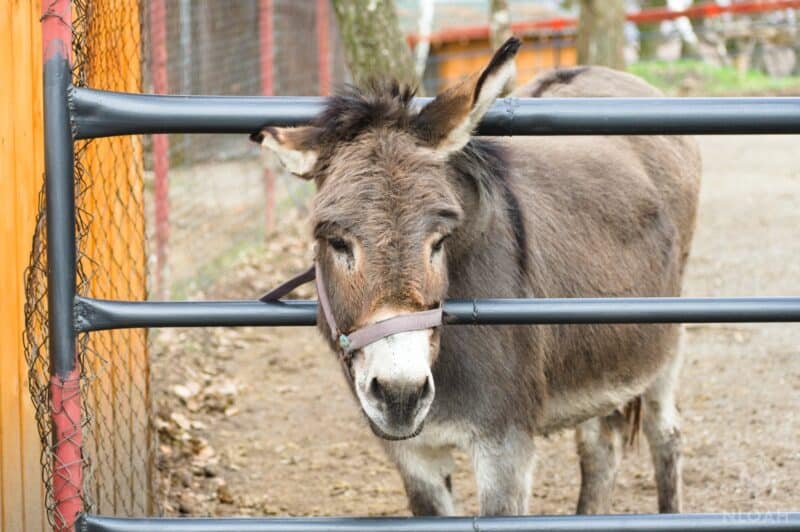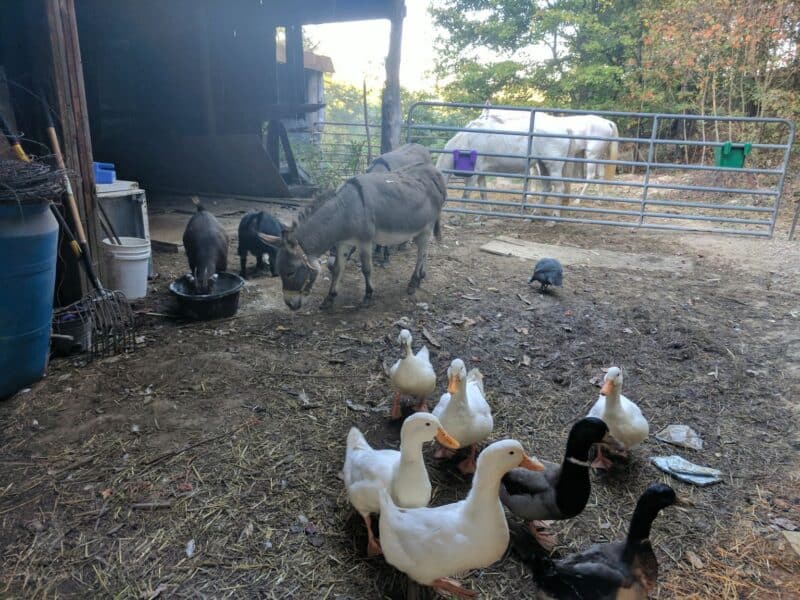Donkeys are known for many things. Stubbornness, endurance, and of course that iconic laugh. This unique “laughing” sound, which is often seen as a sign of happiness or bemusement, is the stock sound that we associate with donkeys!

However, this sound might just be misunderstood by humans who interpret it in the context of their own species. So why do donkeys “laugh”?
No, donkeys don’t actually “laugh” in the way that humans do. Laughing vocalizations are actually known as braying, which is not the equivalent of human laughter.
Braying is done by donkeys when they’re trying to communicate in response to surprise, a threat, as a general alert, or even as a greeting.
In reality, a donkey’s vocalizations serve a very different purpose from out own laughter, though a donkey might still have impeccable comedic timing.
There is a lot more to learn about a donkey’s “laugh” and I will tell you all about it below.
Braying is Not a Laughing Matter
When it comes to comparing the “laughing” hee-haw sound of donkeys with true laughter in humans, there are some important differences to keep in mind.
While humans may laugh as a response to humor or pleasure, donkeys don’t have the same concept of humor or entertainment as we do.
The purpose of braying is very different from human laughter, though it sounds so similar to our ears.
While laughter in humans is primarily a means of social bonding, stress relief and communication, braying in donkeys is focused on practical communication and sometimes survival.
So, Why Do Donkeys Bray?
Considering situations that induce braying, donkeys may make this sound in response to a variety of stimuli. For example, they may bray when they are hungry, thirsty, or in pain.
They may also bray in response to unfamiliar or threatening situations, to express excitement or anticipation, or simply to greet other donkeys.
In essence, braying is a versatile vocalization that donkeys use to express a wide range of emotions and needs.
What are Other Sounds Donkeys Make to Communicate?
In addition to braying, donkeys also make a variety of other sounds that convey different messages.
For example, they may make soft, low-pitched calls to communicate with their young, or bray loudly and aggressively to defend their territory from potential threats.
Moreover, donkeys may also whinny, snort and snuffle to express emotions or alert other animals of their presence in different situations. Their “language” is surprisingly complex!
Caution: Constant Braying Might be a Threat Response to You!
If you have a good relationship with your donkey, it is entirely possible that it will bray in response to your appearance. Basically your donkey is greeting or acknowledging you.
However, it is possible that constant braying is a sign of aggression or fear. If your donkey’s braying continues for an extended period of time, it could be a sign that it feels threatened by you and is trying to ward off perceived potential danger.
In this case, it is important to back away from the animal or leave the area so as not to scare it further…
This type of activity is especially common in male donkeys during mating season, or from females with young. Don’t assume that the animal is happy to see you!
Constant Braying Might Indicate Chronic Pain or Distress
Understand that excessive braying in donkeys can be a cause for concern. If you have noticed that your donkey is braying more than usual, or is doing so constantly, it may be a sign of an underlying issue.
Consider the following when determining the possible source and solutions to your donkey’s incessant braying:
Is your donkey experiencing any pain or discomfort? Observe if there are any signs of lameness, wounds, or swelling in any part of its body.
Are pests and parasites a problem? Has your donkey been dewormed and vaccinated according to their schedule? Are flies, fleas, ticks or any other biting bloodsucker causing pain or discomfort?
Is the donkey eating and drinking regularly? A lack of food or fresh water, or menu fatigue can lead to outbursts.
Check to make sure their diet is balanced and satisfactory. Is the donkey getting enough hay and fresh water to meet its nutritional needs?
Have there been recent changes in the donkey’s living space? Any major change in a donkey’s environment might stress it out. Consider if the donkey is in a high-traffic area where there are a lot of disturbances.
Is the donkey bored or cooped up? Donkeys are notorious for not tolerating confinement very well.
Is the donkey getting enough exercise and interaction with other animals? Donkeys are social! The lack of companionship or regular exercise can take its toll on an animal’s mental health.
It is important to evaluate your donkey’s physical and mental well-being when determining the root cause of their braying so that you can apply the right solution.

How Can You Calm a Braying Donkey?
Once you have examined these points, you can take steps to alleviate your donkey’s excessive braying.
If you believe your donkey is experiencing chronic pain or acute discomfort, call your veterinarian for an appointment immediately.
If the donkey’s environment is the source of the problem, move it to a quieter area or remove stressors from the immediate area.
If you suspect the donkey may not be getting enough nutrition or is just “food bored” adjust its diet accordingly.
If the donkey has undergone any changes to its routine or lifestyle, try to adjust these slowly next time to avoid creating stress or anxiety.
Finally, try to give your donkey more attention and care, and more interaction with other donkeys or other animals they get along with.
Spend time with them, talk to them, and maybe even play with them. This can help to decrease the donkey’s anxiety and help make it feel fulfilled and connected.
If your donkey’s braying continues even after implementing these solutions, you should seek the guidance of a veterinary professional to address the issue.
Tom has lived and worked on farms and homesteads from the Carolinas to Kentucky and beyond. He is passionate about helping people prepare for tough times by embracing lifestyles of self-sufficiency.
